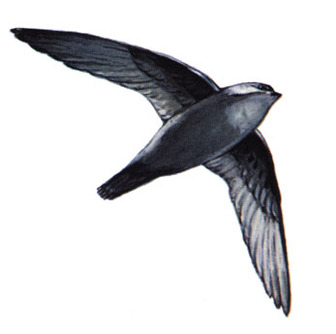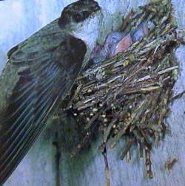Chimney Swift
In flight, this bird looks like a flying cigar with long slender curved wings. The plumage is a sooty grey-brown; the throat, breast, underwings and rump are paler. They have short tails.

The Chimney Swift - A City-Dwelling, Flying Cigar
 For most animals, the expansion of human civilization is a bad thing. Marshes get drained, forests get cut down, and varmints get exterminated. The chimney swift (Chaetura pelagica), is one of the rare few that actually benefit from city living. It commonly nests in chimneys, so cities make for a prime habitat. Before its habitat had lots of buildings and cities, chimney swifts probably nested mainly in caves or hollow trees. Once North America was colonized by Europeans, they had unlimited, convenient chimneys in which to nest. Today, chimney swift populations may actually be declining as a result of newer, closed chimney designs, but it is still designated as "least concern" by the IUCN.
For most animals, the expansion of human civilization is a bad thing. Marshes get drained, forests get cut down, and varmints get exterminated. The chimney swift (Chaetura pelagica), is one of the rare few that actually benefit from city living. It commonly nests in chimneys, so cities make for a prime habitat. Before its habitat had lots of buildings and cities, chimney swifts probably nested mainly in caves or hollow trees. Once North America was colonized by Europeans, they had unlimited, convenient chimneys in which to nest. Today, chimney swift populations may actually be declining as a result of newer, closed chimney designs, but it is still designated as "least concern" by the IUCN.
Chimney swifts are often called flying cigars because of the bird's in-flight appearance. Its cylindrical body resembles a cigar with long, slender wings curving backwards. Coloration is almost always a sooty gray or brown with paler feathers on the underside. The tail is short and square. The chimney swift is a small bird of the Apodidea family, which includes all true swifts and is similar, although not closely related, to the swallows. Most swifts are under 10 inches in length, and the chimney swift is small even for a swift.
Size - 5 to 5.5 inches, or 12 to 14 cm.
Weight - rarely more than an ounce. It can range from 14 to 30 grams on average.
Swifts are some of the most aerial birds in the world; they are rarely seen on trees or other perches. Chimney swifts prefer to use their long claws to roost on vertical surfaces, where they build nests out of twigs and attach them with saliva. They are in flight almost constantly, eating, drinking and even bathing in the air. They feed almost exclusively on flying insects caught in mid-air. Even when they need water, chimney swifts usually just swoop down to the surface and bounce right off without stopping.
These birds are found in and around cities throughout the eastern portion of North America. They're migratory, though, so U.S. residents will only see them in spring and summer. They spend the colder months in eastern Peru and other parts of the Amazon. Chimney swifts are much too small to be eaten by humans, but other predators fare a bit better. Swifts are most commonly eaten by hawks, kites and other raptors. While terrestrial predators don't often get the chance to catch an adult chimney swift, nests are sometimes raided by rat snakes and other opportunistic, tree-climbing hunters.
The Chimney Swift is classified as Least Concern. Does not qualify for a more at risk category. Widespread and abundant taxa are included in this category.

Family : Apodidae
Genus : Chaetura
Species : pelagica
Authority : (Linnaeus, 1758)

